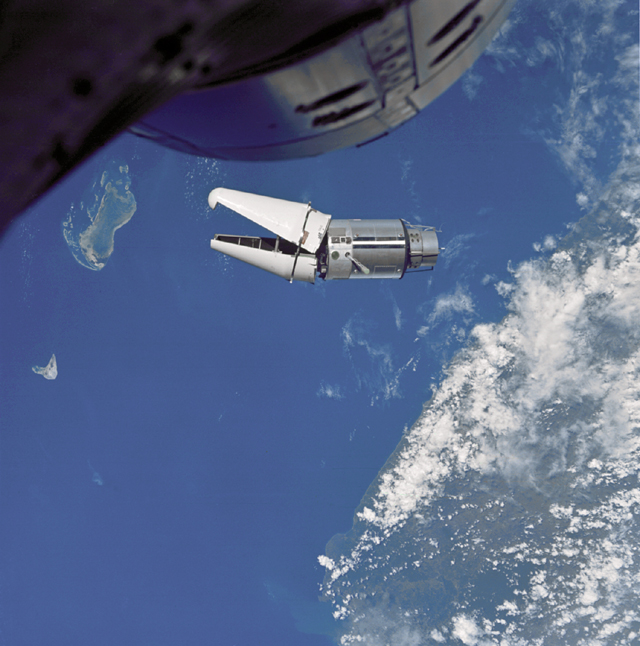Forty-four years ago this month, NASA astronauts Thomas P. Stafford and Eugene A. Cernan became the 7th two-man Gemini crew to orbit the Earth. Known as Gemini 9A, the mission was the 13th manned spaceflight flown by the United States.
The Gemini Program was absolutely critical to the success of America’s lunar landing effort. A total of 10 Gemini missions was flown during a 20-month period between 1965 and 1966. Gemini demonstrated the key capabilities of rendezvous and docking, orbital maneuvering, long duration spaceflight and extra vehicular activity.
Each Gemini mission had its share of difficulties which arose and had to be overcome during flight. Gemini 9A was arguably the most ill-fortuned and technically frustrating of the series. Mission goals included rendezvous and docking with an Agena Target Vehicle (ATV), maneuvering the combined Gemini-Agena combination and demonstration of the first manned rocket pack; the United States Air Force Astronaut Maneuvering Unit (AMU).
The original Gemini 9 prime crew was Elliot M. See and Charles A. Bassett. However, both men died on Monday, 28 February 1966 as they attempted to land their T-38 aircraft during a rain storm in St. Louis, Missouri. The Gemini 9 back-up crew of Stafford and Cernan somehow managed to land their T-38 aircraft during that same storm. The men were appointed as the prime crew with the devastating loss of See and Bassett.
On Tuesday, 17 May 1966, an ATV was launched ahead of Gemini 9. The Agena vehicle never made it to orbit due to a problem with its Atlas booster. McDonnell engineers hurriedly conceived and built a substitute for the ATV known as the Augmented Target Docking Adapter (ATDA). While Stafford and Cernan could rendezvous and dock with the ATDA, they could not change their orbital path since the ATDA had no propulsion system.
With the loss of the ATV and the introduction of the ATDA, Gemini 9 now came to be known as the Gemini 9A mission. The ATDA was successfully fired into orbit on Wednesday, 01 June 1966. However, the ATDA’s nose shroud had failed to jettison. Thus, Gemini 9A would not be able to dock with the ATDA.
The launch window for Gemini 9A was only 40 seconds on the day that the ATDA was launched. That window came and went when computer problems arose at a most inopportune moment. Having been denied the opportunity to launch, Stafford and Cernan unstrapped and waited to fly another day.
On Friday, 03 June 1966, Gemini 9A lifted-off from LC-19 at Cape Canaveral, Florida. Lift-off time was 1339 UTC. Within 5 hours, the crew caught up with the ATDA. What they saw did not inspire hope. The ATDA’s shroud indeed had not jettisoned properly. Commander Stafford radioed to Mission Control: “It looks like an angry alligator out here rotating around.”
The Gemini 9A crew asked for permission to use the nose of their spacecraft to nudge the recalcitrant shroud from the ATDA. Permission denied. The Gemini spaceraft might be damaged. How about performing an EVA and having Cernan cut the shroud attachment lanyards? No way. Sharp-edged debris might pierce Cernan’s EVA suit.
Making the best of the situation, Stafford and Cernan moved away from the ATDA and then rendezvoused with it again. They did this a number of times to gain practice. They also performed stationkeeping with the ATDA to learn the nuances of that flight mode.
Cernan’s much anticipated EVA with the AMU took place on Sunday, 05 June 1966. That particular experience deserves an article all its own. Suffice it to say that things did not go well. Working outside the spacecraft was much more physically demanding and functionally non-intuitive than expected.
Cernan found that any movement of his limbs resulted in unwanted reactions on his body. It was exceedingly difficult to remain still and perform useful work. He had to continually fight to maintain body position. Further, the Gemini spacecraft did not have enough hand-holds. Cernan’s exertions were such that his heart rate peaked at 195 beats per minute. Perspiration fogged his visor. Now he was blind.
Cernan struggled to get to the AMU which was stored in the Gemini’s aft adapter. He prepared the unit for free-flight, but continued to labor. He ultimately came to the conclusion that free-flying the AMU was infeasible on this mission. Dishearted and still blinded by the perspiration-induced fog on his visor, Cernan managed to safely return to the spacecraft cabin and secured the hatch. Total EVA time was 128 minutes.
Stafford and Cernan completed their demanding mission with reentry and splashdown in the Atlantic Ocean on Monday, 06 June 1966. They excuted a computer-controlled entry and landed less than one-half mile from the prime recovery ship; the USS Wasp. Official mission elapsed time was 72 hours, 20 minutes and 50 seconds.
It is worth noting that Gemini 9A, like all Gemini missions, was a test flight. The ATDA and AMU experiences were certainly frustrating, but not without merit from a learning standpoint. That learning was put to good use as evidenced by the accomplishments of Gemini’s 10, 11 and 12.
Rendezvous, docking and orbital maneuvering with the ATV all went extremely well on the last trio of Gemini missions. And on Gemini 12, the most vexing of early manned spaceflight problems was solved; that of EVA. Indeed, with the aid of techniques and equipment developed from Gemini 9A lessons-learned, one Edward E. “Buzz” Aldrin convincingly demonstrated the feasibility of an astronaut performing meaningful work in space.


